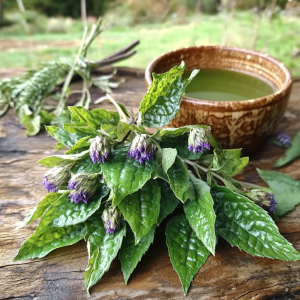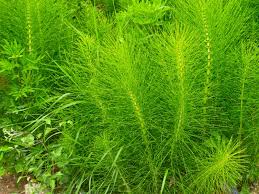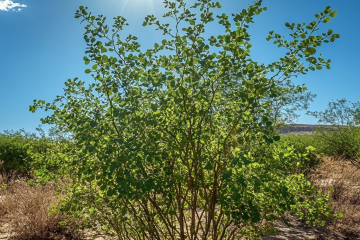
Comfrey, the superhero medicinal herb
The Merits of Comfrey
Attention all green thumbs and wannabe herbalists! If you’re looking for a plant that’s as easy to grow as your enthusiasm for apocalypse preparedness, look no further than comfrey. This miracle herb is so hardy it might just outlive your canned goods stockpile. Comfrey grows faster than your neighbor’s suspicions about your backyard bunker, and it’s about as difficult to kill as that houseplant your great-aunt gave you that somehow survives on neglect and spite.
But comfrey isn’t just a pretty face in your garden. Oh no, this overachiever of the plant world has been used medicinally for centuries. Got a bruise from your latest attempt at chopping firewood? Slap on some comfrey. Sprained your ankle running from imaginary zombies? Comfrey to the rescue! Its leaves and roots contain allantoin, a compound that promotes cell growth and skin healing. You can make poultices, salves, and teas that would make any medieval herbalist green with envy.
Now, let’s get down to the nitty-gritty of how to actually use this wonder plant. When I say “slap it on,” I don’t mean you should be out there whacking yourself with comfrey leaves like some sort of botanical self-flagellation ritual (though that would certainly be a sight for the neighbors). For bruises, sprains, and other external boo-boos, you’ll want to make a comfrey poultice. Here’s how: Harvest some fresh comfrey leaves. If you’re feeling fancy, you can also dig up some roots. Chop up the leaves (and roots if using) until they’re finer than your end-of-the-world escape plans. Add a bit of warm water to create a paste. Aim for a consistency that’s spreadable but not runny – think mashed potatoes, not soup. Spread this green goo directly on the affected area. Cover with a clean cloth or bandage. Sit back and let the comfrey work its magic for about 30 minutes to an hour.
If you’re more of a “set it and forget it” type, you can make a comfrey salve. Start by drying your comfrey leaves and crumbling them up. Heat the crumbled leaves in a carrier oil (like olive oil, jojoba oil, or grapeseed oil) over low heat for a few hours. Strain out the plant material, then melt some beeswax into the oil. Pour into containers and let it cool. Voila! You’ve got yourself a shelf-stable comfrey salve that you can slather on scrapes and bruises faster than you can say “I told you prepping wasn’t crazy!”
But wait, there’s more! Ha! Comfrey isn’t just a one-trick pony for your medicine cabinet. This plant is the ultimate wingman for your fruit trees too.

Turn comfrey into a salve or poultice
Planting comfrey around your fruit trees is like giving them their own personal nutrient delivery service. Here’s the deal:
Comfrey’s roots are like the overachievers of the plant world, diving deep into the soil to bring up nutrients that fruit trees can’t reach on their own. It’s as if you’ve got your own little team of underground miners, excavating nutritional gold for your orchard. But comfrey doesn’t stop there – oh no, it’s got more tricks up its leafy sleeves. Those large, lush leaves? They’re not just for show. They make excellent “chop and drop” mulch, creating nature’s own compost delivery system right at the base of your trees. No wheelbarrow required – just snip, drop, and let Mother Nature do the rest.
As if that wasn’t enough, comfrey is also a bit of a social butterfly. It attracts pollinators like bees are drawn to, well, honey. More pollinators mean more fruit, so it’s essentially like hiring a free matchmaking service for your fruit blossoms. Talk about being a good wingman! And for the grand finale, this wonder plant creates a living mulch around your trees, effectively evicting those unwanted plant squatters (aka weeds) from your orchard. It’s like having a bouncer for your soil – keeping the riffraff out and the good stuff in.

Orchards benefit from comfrey
Now, here’s a fun fact that might make you raise an eyebrow: some orchard owners have been spotted doing what looks like a bizarre rain dance around their trees, stomping on the comfrey plants. No, they haven’t lost their marbles – there’s actually a method to this madness. You see, stomping on comfrey is like giving it a stern talking-to. It says, “Hey, buddy, time to share all that goodness you’ve been hoarding!” This tough love approach encourages the comfrey to release its nutrients more quickly into the soil. It’s also a way to manage its growth without completely uprooting it. So, if you see your neighbor doing the comfrey cha-cha in their orchard, don’t call the authorities – they’re just practicing some advanced gardening techniques. And who knows? It might just become the next TikTok dance craze. #ComfreyStomp, anyone?
Now, before you go replacing your entire medicine cabinet with comfrey concoctions, a word of caution: while it’s great for external use, internal use of comfrey is controversial. Some herbalists traditionally used comfrey tea for various ailments, but modern research has raised concerns about potential liver toxicity when ingested. So, let’s stick to external applications, shall we? Using comfrey internally is about as advisable as using poison ivy as toilet paper – it might work, but the risks far outweigh any potential benefits. There are plenty of other alternatives such as Calendula, Marshmallow Root, Plantain Leaf, Gotu Kola, and Horsetail. You can also use Aloe Vera juice.
Deliberately growing comfrey may just be a boon that you need in a crisis as it would put you in high demand amongst others if you’re able to make a supply of poultices and salves. So there’s that to consider. #FinancialPreparedness
So, whether you’re prepping for the end times, want to impress your gardening club, or are aiming to win the neighborhood’s “Best Fruit Tree Parent”

Instead of ingesting comfrey, use horsetail tea
award, comfrey is your go-to plant. It’s like the Chuck Norris of the herb world – tough, versatile, and slightly intimidating to those who don’t understand its power. Happy planting, and may your comfrey be ever bountiful, your poultices always soothing, and your fruit trees eternally grateful!


